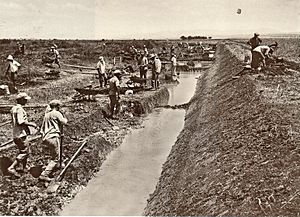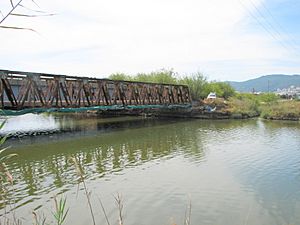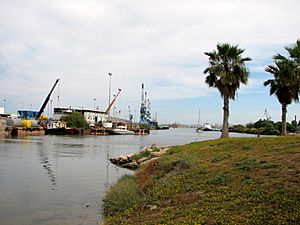Kishon River facts for kids
Quick facts for kids Kishon River |
|
|---|---|
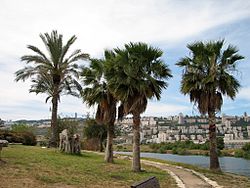
Kishon River near Haifa in 2010
|
|
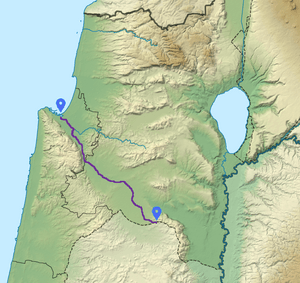 |
|
| Native name | Nahal Kishon |
| Country | Israel |
| District | Haifa District |
| City | Haifa |
| Physical characteristics | |
| Main source | Gilboa mountains |
| River mouth | Shefekh haKishon Haifa Bay, Mediterranean Sea |
| Length | 70 km (43 mi) |
The Kishon River is a river in Israel that flows into the Mediterranean Sea. It is about 70 kilometers (43 miles) long. The river starts in the Gilboa mountains and flows through the Jezreel Valley. It finally reaches the Haifa Bay near the city of Haifa. The area that drains into the Kishon River is about 1,100 square kilometers (420 square miles). This area includes much of the Jezreel Valley, parts of the Western Galilee, and some of Mount Carmel.
Contents
Kishon River: A Look at Its Modern History
After the First World War, more Jewish people came to live in Palestine. This was known as the Third Aliyah. Many of these new arrivals came through Haifa. They stayed in special tent camps set up near the Kishon River's mouth. These were called Quarantine Camps.
Sadly, many immigrants, known as Halutzim, got malaria. This disease was common in the area. Later, under the British Mandate (when Britain governed the area), the Kishon River region became an important industrial zone for Haifa. A power station, railway workshops, and an oil refinery were built there.
Understanding Pollution in the Kishon River
For many years, the Kishon River was known as the most polluted river in Israel. This caused a lot of discussion about how to make its water cleaner. The pollution came from nearby factories. For over 40 years, these factories released harmful substances into the river. These included mercury, other heavy metals (like lead or cadmium), and various organic chemicals.
In 2000, some people even said the river had more chemicals than water! It was claimed that just washing your hands in the river could cause serious chemical burns. Sometimes, patches of oil and chemicals on the river would even catch fire.
How Pollution Affected River Life
A study in 2002 looked at how the river water affected fish. It found that exposing rainbow-trout liver cells to Kishon River water for just three hours caused a lot of damage to their DNA. This damage was three times worse than what happened with clean water. The lower part of the Kishon River, near the chemical factories, was especially harmful.
What Pollutants Were Found?
An analysis of the river water in 2000 showed different types of pollution. Chemical factories released chlorinated compounds. The city's sewage treatment plant and a fertilizer factory also added to the pollution. Heavy metals were found in the waste from other chemical plants.
Even the upper parts of the river system were affected. Waste from homes and water running off farms (called agricultural runoff) also added harmful materials. This runoff often contained pesticides and fertilizers. Domestic waste can also contain harmful chemicals like N-nitroso compounds and aromatic amines. These are found in human waste. Also, PAHs, which are harmful chemicals, were found in city wastewater.
Efforts to Improve Water Quality
Since January 2016, a large amount of clean drinking water (1,000,000 cubic meters per year) has been added to the Kishon River. This has helped a lot! The levels of salts, nitrates, and phosphates in the river have dropped by more than 50%. In the future, springs from the Jezreel Valley will provide this clean water, as their flow is no longer needed for irrigation.
Cleaning Up the Kishon River
In 2012, the Israeli Ministry of Environmental Protection started a big project to clean up the Kishon River. This project cost about 220 million Israeli New Shekels (NIS). A lot of the money for this cleanup came from the companies that had caused the pollution. A Canadian company called EnGlobe Corp. began the cleanup work in 2012.
Images for kids
See also
 In Spanish: Río Kishon para niños
In Spanish: Río Kishon para niños


